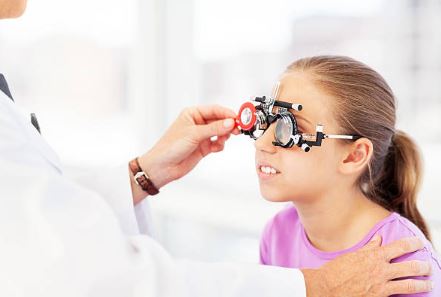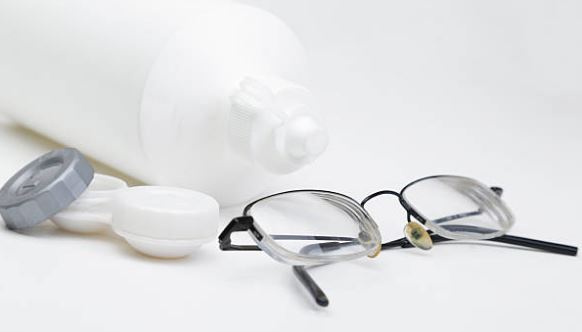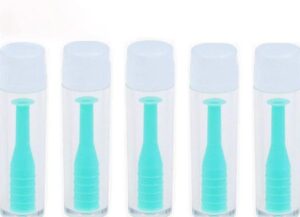A corrective lens that floats or rests on the cornea (contact lens) or a glass or plastic lens mounted in a frame (eyeglasses) can both be used to correct refractive errors. Either eyeglasses or contact lenses can effectively correct vision. The decision is usually based on comfort, cost, risk, convenience, and appearance.
Table of Contents
What Are Corrective Lens?
In order to treat refractive errors like myopia, hyperopia, astigmatism, and presbyopia, corrective lenses are typically worn in front of or on the eye. In order to see clearly, your eyes need to focus light onto your retina properly, which is assisted by corrective lenses. To accomplish this, light rays are bent to the extent necessary by your specific condition (before they enter the eye).
What Are the Types of the Corrective Lens?
There are three types of corrective lenses listed as follows.
Glasses
Corrective lenses are worn on the face just in front of the eye with glasses. There are several types of glasses, primarily:
- Monofocal: This kind of lens only has one focal point. This enables the wearer to see objects close up or far away.
- Bifocal: This type of lens has two segments, the smaller lower segment being used for close-up vision and the larger upper segment being used for distance vision. The division of sight distance is shown by clearly visible lines.
- Trifocal lenses: These allow for far, middle, and close-up vision.
- Progressive lenses provide the same functionality as bifocal and trifocal lenses while enabling a more seamless transition between the focal points. The various prescriptions are not divided by a line that can be seen.
Contact Lenses
In front of the eye’s surface, these corrective lenses are worn. Contact lenses come in the following types:
- Disposable – These are worn just once and then discarded at the end of the day.
- Daily Wear: These lenses should only be worn during the day and stored overnight in a sterile solution.
- Extended Wear – These can typically be left on for up to seven nights without being taken off.
- Bifocal contacts: These lenses combine near and far vision into a single lens.
- Rigid Gas Permeable (RGP) – This is a hard lens that gives some patients clearer vision.
- Patients with astigmatism may benefit from toric lenses because they can improve vision.
Contacts
The cornea, or clear surface of the eye, is covered by tiny, plastic discs called contacts. More than 30 million people live in the United States, according to the Centers for Disease Control (CDC). wear contacts and 2/3 of contact wearers are female. Nearsightedness, farsightedness, and astigmatism can all be treated with contacts, just like with glasses.
The majority of people wear soft lenses, though there are other types of contacts as well. These thin lenses typically feel comfortable on your eye. Depending on the type of contact lenses you purchase, soft contacts can be worn just once and discarded or worn repeatedly for weeks or months.
- Single-use lenses are worn for only one day and then thrown out.
- Daily wear lenses are worn during the day and taken out at night. After several weeks, you throw them away. However, despite being less expensive, they require frequent cleaning.
- Extended-wear lenses are worn day and night for a certain number of weeks. They are more susceptible to infections and other eye conditions.
What is the Difference Between Corrective Lenses and Glasses?
Eyeglasses, also called spectacles, contain corrective lenses held within frames. Myopia, hyperopia, astigmatism, and presbyopia are just a few of the vision issues they can treat, along with other conditions that corrective lenses can treat. To suit the patient’s specific vision requirements, prescription eyeglasses are made to order.
Do You Need Prescription Lenses?

Even though you might have had 20/20 vision last year, as you age, your vision will likely change, and you may now have near- or farsightedness in one or both of your eyes. Additionally, common effects of aging that reduce vision clarity are astigmatism and cataracts. You might unintentionally be straining your eyes as a result if you don’t have the required corrective lenses.
Do Corrective Lenses Fix Your Eyes?
Can You See Better With Glasses? Wearing glasses will help improve your eyesight only when you are wearing them. Treating the underlying cause of your eye problems is necessary if you want to see better without wearing glasses. Only the vision correction provided by your glasses will be in accordance with your current prescription.
How Do I Know If I Need Glasses?
It’s possible that you need glasses or contacts if you’re having difficulty reading or seeing the blackboard. You might need a new prescription if you already wear contacts or glasses because your vision may have changed. Because they make it challenging to write, read, or do the math, learning disabilities can also contribute to reading difficulties. To determine why you are struggling to read, it is crucial to visit a doctor.
Why Do I Need Glasses Or Contacts?
Many teenagers have trouble seeing things up close or from a distance. This is called a refractive error and is the most common type of eye problem. The abnormal shape of the eyes results in refractive errors. This indicates that the eye does not effectively bend light to form a clear image.
One way to correct vision and improve eye clarity is to wear glasses or contacts.
You may have a refractive error if:
- Your vision is blurry or hazy
- You have headaches
- Your eyes hurt
- You see a glare around bright lights
- You have to squint to see well
- You see double
- You have trouble driving at night
When Should I Wear My Glasses?
- Wear your glasses as often as you require them for vision. This might happen constantly or just occasionally. Always carry your glasses with you so you’ll be sure to have access to them if necessary.
- If you require them, bring your glasses with you to the driving test and wear them. Wear your glasses whenever you drive if your driver’s license lists corrective lenses as being worn.
- When playing sports or engaging in other physical activity and needing your glasses, wear sports goggles. While playing sports, REMOVE your regular glasses. Your eyes could suffer serious damage if your glasses break. Sports goggles are safe and designed to protect your eyes. They can be made with the same prescription as your eyeglasses.
How Do Glasses and Contacts Work?
Let’s first go over how your eyes see in order to comprehend how corrective lenses function. Light is focused on the retina, or back of the eye, by lenses in your eyes. Light is transformed by the retina into electrical signals and sent to the brain. These signals help the brain build an image of what you are seeing.
The incoming light is bent by the cornea and lens to focus the image on the retina, which is found at the back of the eye. (See image)
The eyes of many people have odd shapes. This implies that the lens is unable to direct light toward the retina. Light can fall in front of or behind the retina depending on the type of vision issue you have. An image that results from this is hazy.
Glasses and contacts reorient light so that it strikes the retina and produces a clear image.
How To Have Corrective Lenses Glasses?

Since the time of the ancient Egyptians, eyeglasses have been worn, and they now function even better. It’s simple to wear and maintain glasses.
Choosing Frames: Glasses’ frames are the component that houses their lenses. They are available in a wide range of sizes, colors, materials, and shapes. You will be able to select the shape or style that flatters your face the most. However, some frames will fit more comfortably than others.
Here’s what you should look for:
- Pick eyeglasses that don’t touch your cheeks or eyelashes.
- Ensure that the lenses are centered over your eyes.
- For the best fit, adjust the components behind the ear and the pads close to the nose.
Other things to think about:
- There are frames that last longer than others.
- Frames that are spring-loaded are less likely to warp or bend.
- Nose pads add comfort and stop the glasses from slipping on your nose.
How Long Do You Wear Corrective Lenses?
Optometrists recommend updating to new glasses every one to three years as needed. Various factors, though, might be pointing to the need for new prescriptions to replace our outdated ones. It’s a common misconception to wear outdated prescriptions and think your eyesight will still be fine.
How Much Do Corrective Lenses Cost?
According to data from VSP, the average price of glasses without insurance is $242. That only applies to frames. For basic, single lenses, it’s $113. In other words, if you don’t have vision insurance, the total will cost you on average about $351 for a full pair of glasses.
Do you know more about corrective lenses? Which type of corrective lenses fits you? Besides, Plano (non-prescription) blue light-blocking glasses might be a good investment even if you have 20/20 vision and don’t require corrective lenses. These glasses lessen eye strain from using a computer and a phone, and they might even help lower the risk of age-related macular degeneration.


